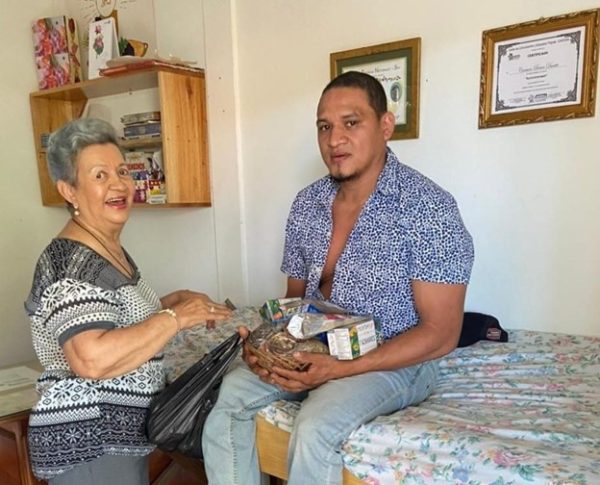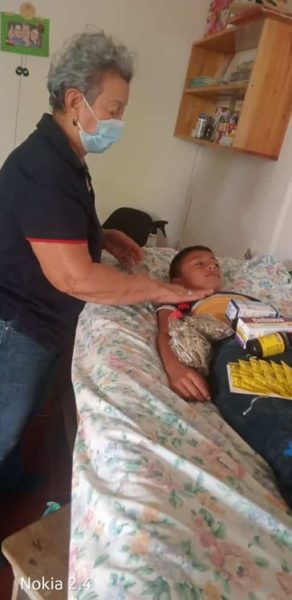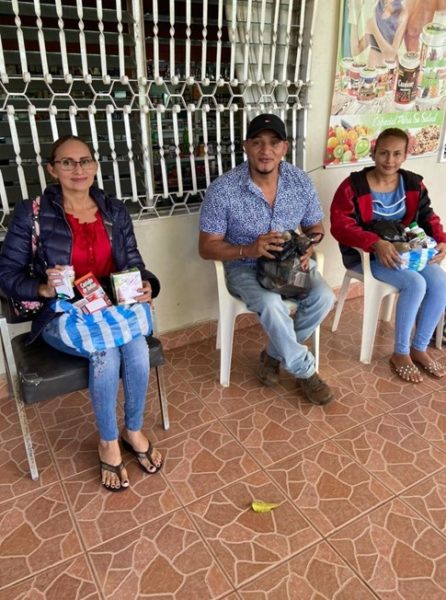Doña Carmen, a Famous Natural Healer in Chontales, Nicaragua

Doña Carmen Bravo Duarte’s best allies are her patients, who have taken on the job of extolling the effectiveness of her methods
By Guillermo Rothshuh Villanueva (Confidencial)
HAVANA TIMES – When I first learned of the life and miracles of doña Carmen Bravo Duarte, I recalled a remark made by Depak Chopra, a doctor, lecturer, writer, and winner of the 1998 Nobel Prize for physics. In one of his many books on spirituality, he noted sadly that the United States’ health system relied on tubes and machines, while in India they used small needles and infusions.
Doña Carmen uses the latter methods. She learned to do so encouraged by Father Ignacio Gonzalez, a Catholic priest who was a native of Colombia. Father Ignacio had the vision to invite doctor Atom Inoue, a Japanese specialist in homeopathic medicine living in Leon at the time, to come and offer courses in this type of medicine in El Coral, a municipality in southeastern Chontales. The classes were a revelation to doña Carmen.
She had come to live in that locality with her husband in 1975, 20 years before these classes began. At the time, El Coral was still a community in the municipality of Villa Somoza. The priest made the decision to invite the Japanese specialist, given the urgent need to provide some medical attention to the poor, especially the rural poor. Poor Nicaraguans lacked the resources to visit a doctor, and it was impossible for them to get to the hospitals. When the priest was able to confirm the effectiveness of natural medicine, and of the treatments that Inoue was offering, he began promoting these courses.
When she finished the classes in 1995, doña Carmen felt attracted to the way that Dr. Inoue cured diseases. She witnessed the effectiveness of steam baths, the importance of healing through acupuncture, the use of pressed and fresh native plants, including lemon grass, cinnamon, epazote, bitter orange, mango leaves, guarumo leaves, chamomile, rosemary, etc.
Doña Carmen’s use of bio-energetic medicine clashed with those who saw these practices as witchcraft or demonic. The crusade against her didn’t intimidate her, and she continues to this day, although the criticisms have never stopped. Her detractors weren’t even persuaded when the Bishop Emeritus of Chontales and Rio San Juan, Monsignor Bernardo Hombach, recurred to her curative methods on several occasions, desperate to find a way to diminish his back pain. Among other methods, doña Carmen used urine therapy, a practice that is ever more widespread. “How is the urine therapy lady doing?” Bishop Hombach would greet her ironically, while rigorously following the prescribed treatment – small pellets stuck to his back at the points used in acupuncture.
The first one to encourage doña Carmen had been a priest, and priests continued being the first to endorse the virtue of her treatments. Father Nelson Gonzalez from the old parish of the Juigalpa Cathedral and former director of philosophy studies at the Chontales branch of the Juan Pablo II University was forced to look for an alternative medical treatment, given the very limited results of the medicines he was taking to eliminate an H. pylori infection. He came to doña Carmen, and she put an end to his torment. “God has given doña Carmen the gifts she possesses. She’s very efficient, and her help was key to my healing. She has a heart that’s open to the service of others,” says the man who was formerly in charge of the Chontales Lower Seminary, in admiring and generous recognition of her altruism.

Not only religious leaders initially questioned her methods, but also the doctors stationed in El Coral. Many people noted the radical differences between the treatments the doctors prescribed and those indicated by practitioners of natural medicine. They insulted them, calling them witches or shamans, displaying an attitude like that of the Rockefeller family at the beginning of the 20th century. When they became oil barons, the latter began advocating the drugs based on petrochemistry. In order to promote the use of these pharmaceuticals, the Rockefellers railed against the enormous prestige that folk medicine enjoyed at that time in the United States. Over half the doctors combined the medicine that came from Europe with the medicine applied by the Native Americans. To remove that stumbling block, the Rockefellers dedicated themselves to discrediting that type of medicine, and in that way offer their own products.
Time and the successful results of homeopathy or holistic medicine have put things in their place. The disputes between homeopathic and allopathic medicine have diminished. The deans of the Harvard School of Medicine, the prestigious US university, decided to incorporate homeopathy in their professional development curriculums. The mere fact that a university of such world renown decided to end the controversies first fanned by the Rockefellers, marks a qualitative leap. It’s now a sterile mission to deny the existence of this medicine. The results obtained by those who exercise natural medicine and the testimonies of those benefitted indicate that there’ll be no turning back now that medical schools recognize their importance.
Her staunchest allies
Doña Carmen’s best allies are her patients, who have taken on the job of extolling the effectivity of her methods. As the saying goes: “a small town is a large hell,” and in a city with little over four thousand inhabitants, and only two private doctors, the presence of doña Carmen is uncomfortable for them. When asked why the doctors held a grudge against her, she didn’t hesitate to tell me: “They’re jealous.” She’s not wrong.
Patients come to her practice from beyond the Chontales department, in search of a cure. She’s had people come from Juigalpa, San Carlos, El Almendro, Nueva Guinea, El Rama, Bluefields and Camoapa. The patients themselves praise her procedures to their relatives and friends, and that’s her best publicity. She continues loyal to the legacy of the Colombian priest, and those who have no money don’t pay for her services.
Opinions among the Catholic clergy are divided. They certainly can’t question her faith in God. Doña Carmen is a very devout Catholic believer and when she resolves difficult cases, she exclaims: “This isn’t my doing, it’s the work of God.” On other occasions she’s stated that she “feels blessed by the Lord.” One of her most frequent phrases is: “In the name of God.”
Contrary to those who accuse her of being a witch, she has an undeniable spirituality. Do her detractors ignore or fail to understand her praises to the Lord? Franciscan priest Orestes Tellez was the one who convinced bishop Hombach that he should try the services of doña Carmen, because he believed that she was the indicated person to help him improve his chronic spinal pain and his renal and digestive problems. Hombach saw nothing Satanic in her attention.

Many find the presence of people who specialize in natural medicine incomprehensible. Given the impossibility of finding a plausible explanation for it, they easily slide into discredit and defamation. Not even when presented with evidence, do they give any credence to the validity of its results. Their blindness leads them to denigrate the practice and to put their efforts into smears and epithets, without making the least effort to separate the wheat from the chaff. Clearly, the sphere of medicine does contain some charlatans who merit denunciation, but doña Carmen is the complete opposite of a scammer. Hundreds of testimonies confirm her stature as a healer.
Father Tellez was the first priest attended by doña Carmen when he lived in El Coral. After he was transferred to Rio Blanco, having experimented the virtues of the healer from Chontales, he became her advocate. A number in his congregation were sick, so he spoke to them of the woman in El Coral who was dedicated to natural medicine, saying that he could ask her to come to Rio Blanco and help them. Doña Carmen traveled back and forth over a two-year period, carrying her medical instruments and medicines with her. In Rio Blanco, she received warm acceptance, and she only stopped going when her children begged her to, fearing that something could happen to their mother, given the dangers and the bad state of the highway. Eventually, she ceded to their wishes. However, many people in Rio Blanco resented her absence and to this day lament it.
Her critics perhaps don’t realize that – given the need to extend her knowledge – doña Carmen has taken different academic classes. She took classes for over a year at the Mt. Tabor Medical Academy, and also attended classes in physical therapy at the Medical School of the National Autonomous University of Nicaragua (UNAN) in Managua. As a member of the Women’s Network of the Center for Communications and Popular Education (Cantera), she was able to enroll in courses in auriculotherapy, a branch of acupuncture. Still hungry to learn more about this practice, she traveled to Honduras to broaden her knowledge of this subject, but regretfully, was unable to finish. The breadth of her studies is the greatest argument against those who offend her, trying to avoid or ignore her many credentials.





